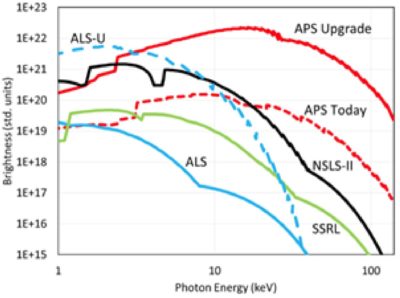Brightness in Undulators: Challenges & Opportunities
- August 26, 2021

The Importance of Brightness in Undulators
X-ray light sources are a key instrument for scientific discovery in disciplines ranging from biology to materials science to organic chemistry. These light sources are powered by undulators and are used, among other purposes, to examine the ultrafine structures of samples that are under investigation. The ability to measure such fine structures necessitates a high signal-to-noise ratio in the X-ray beam. The beam’s brightness dominates this signal-to-noise ratio, making that brightness a fundamental figure of merit for the undulator. Brightness is such an important feature that the ability to accurately calculate it determines how far beamline designs can advance.
Current and Potential Brightness of Light Sources
The light sources currently in use show wide variation in brightness and photon energy, with significant improvements anticipated as devices and facilities are updated. Figure 1 (at the top of this article) shows that the brightness of beams produced should increase by two orders of magnitude in the near future. Reaching these hoped-for brightness levels will require overcoming serious difficulties that are rooted in both the beamlines and their sources.
Challenges to Increasing Brightness
One of the challenges to increasing brightness in the beamlines is that their complicated behaviors require high-level mathematics to predict, which in turn requires training and retaining people who can do that work. Brightness calculations require knowing the emitted radiation of the undulator, the photon beam size and divergence, the electron beam energy spread, the photon flux, etc. The math gets twisted pretty fast. Photon flux, for example, is represented by the formula in Figure 2.
Figure 2. Photon Flux Calculations
The components of the photon flux formula are themselves complicated. The formulas for ,
,
, and
and
are demonstrated in Figure 3.
Figure 3. Additional Calculations
The shifting variables and nested complexity of these mathematical formulas make them difficult to work with or discuss in depth in a blog post. (The references listed at the end of this article provide details for further study). For the purposes of this piece, it’s enough to recognize this barrier to advancement in the field.
Moreover, light sources themselves are enormous and intricate devices; they can cover acres of ground and have thousands of delicate moving parts that require indescribably-minute adjustments in real time. These adjustments must be done by a phalanx of highly-trained engineers and support staff. Suffice to say that any experiment run in such devices is enormously difficult and expensive. Scientists will need to find pathways to lower barriers in both the beamline calculations and the light-source generation in order to continue advancing the field.
Opportunities for Lowering Barriers
The value of high-stakes scientific experiments is, of course, in their complexities. It is neither possible nor desirable to remove them. Lowering barriers to navigating them should be a focus among the community.
The obvious solution is to use software and computational power to handle the calculations and model the behavior of the beamlines and light-source devices. Modeling instead of executing “real” experiments reduces the expense and increases accuracy by orders of magnitude. The sticky bit is that these software programs can be challenging to learn, hard to use, and difficult to share. To truly lower these barriers, another boost is needed. Bringing the simulation codes into a browser or other GUI-based platform can be that boost.
Wrapping the legacy codes in a GUI makes them accessible to scientists and engineers at all stages of their careers. Removing the necessity of learning command-line operations means that any of the multiple codes suitable for X-ray brightness calculations can be used with equal ease. “Drag and drop” inputs make adjustments fast and cheap and multiple iterations easy. GUIs also provide greater visualization capabilities as well as ease of sharing between collaborators.
Using GUI technology to facilitate calculating and modeling tasks is not a silver bullet that removes all barriers. But it is a powerful tool that should be recognized and utilized as scientists seek to achieve the ever-brighter beams that are needed.
Conclusion
Synchrotron radiation production is a hugely important engine for scientific productivity, with applications ranging from basic science to medicine to industry. It is and will continue to be ever-more important to lower barriers both to accurate calculations of brightness and modeling of beamlines in order to advance the development of light sources. Browser-based or GUI technology can lower barriers dramatically and will be an ever-bigger part of the progress in the field of beamline generation. Improving our ability to efficiently quantify the performance of light sources will bring a bright new tomorrow to the light-source community.
References & Resources
The information in this article is drawn from several sources. Please see the references below for further information.
Nash, O.Chubar, N. Goldring, D.L. Bruhwiler, P. Moeller, R. Nagler and M. Rakitin, “Detailed X-ray Brightness Calculations in the Sirepo GUI for SRW,” AIP Conference Proceedings 2054, 060080 (2019); https://doi.org/10.1063/1.5084711
Nash, O.Chubar, D.L. Bruhwiler, M. Rakitin, P. Moeller, R. Nagler, and N. Goldring “Undulator radiation brightness calculations in the Sirepo GUI for SRW,” Proc SPIE 11110, 111100L(2019); http://doi.org/10.1117/12.2530663
M.S. Rakitin, P. Moeller, R. Nagler, B. Nash, D.L. Bruhwiler, D. Smalyuk, M. Zhernenkov and O. Chubar, “Sirepo: an open-source cloud-based software interface for X-ray source and optics simulation,” Journal of Synchrotron Radiation 25, 1877 (2018); https://doi.org/10.1107/S1600577518010986
K.-J. Kim, “Brightness, coherence and propagation characteristics of synchrotron radiation,” NIM A 246, p71 (1986)
This work is supported by the U.S. Department of Energy, Office of Science, Office of Basic Energy Sciences, under Award #DE-SC0011237

